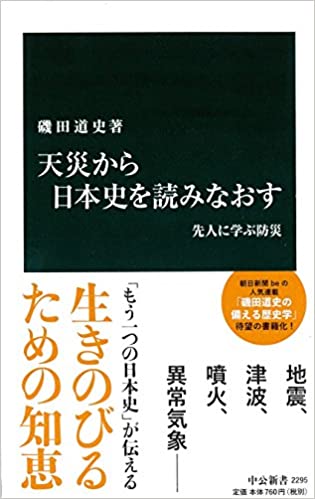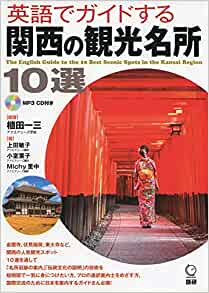磯田道史著「天災から日本史を読みなおす」中公新書
御存知、磯田先生の本です。「天災から」というタイトルですが、いろいろとトリビアな知識を得ることもできます。
まずは、豊臣秀吉に関していくつか紹介します。天下人になると、他の人よりも偉いと思うのは致し方ないとしても、秀吉は神仏さえも、自分の思い通りにさせようとしていたようです。
例えば、伏見稲荷に関して引用すると、「1597年、養女の豪姫にキツネが憑いた時、稲荷大明神を恫喝した。『滅多なことをしたら社を即刻破却。日本中で毎年キツネ狩りをしてキツネ類を全滅させる』。伏見稲荷にそんな書状を出している。」と、自分自身を神仏の上に立つ絶対者と位置付けていたようです。
天災の話ですと、地震の多かった江戸についての話が紹介されています。江戸で地震が発生すると、大名は将軍様に、ご機嫌うかがいの使者を出します。ただ、今みたいに震度いくつとか、マグニチュードいくつという指標がありません。そのために、どの程度揺れたら使者を出すか、参考にされたのが天水桶でした。天水桶の水がこぼれたら、使者を送ったそうです。ちなみに天水桶の水がこぼれるのは、震度4以上ですから、なかなかの基準設定であったと思われます。
仕事で時々訪れる、大阪の岸和田についての記述もありました。だんじり祭りで有名な街ですが、お城もあり、3層の天守が復興されています。その岸和田藩は岡部家に治められていました。そして、50人の甲賀衆を抱えたいたそうです。甲賀衆とはすなわち、甲賀者の忍者です。以下引用すると、「50人の内、四十数人が甲賀に住んで農民の姿をしていたが、それでも順番に岸和田の城下に出て藩の御用を勤めた。有事の際には、鉄砲などで全員が武装して出陣した。忍術書を持っている家も多いから、本来は甲賀忍の集団であったのだろう。」戦国時代に活躍した忍び達も、泰平の世になった後は、各藩で警護などの役で雇われていたそうです。
新書ですので、気軽に読める話が多く、ガイドの際に役立つ話を見つけてみてください。(完)

天災から日本史を読みなおす 先人に学ぶ防災 (中公新書) [ 磯田道史 ]
価格:836円
(2021/5/22 18:17時点)
感想(10件)
“Rereading Japanese History from Natural Disasters” by Michifumi Isoda, Chuko Shinsho
This is a book by the well-known Professor Isoda. Although the title of the book is “from natural disasters,” you can also gain trivia knowledge from it.
First, let me introduce some information about Hideyoshi Toyotomi. When you become a ruler, it is inevitable that you think that you are more powerful than others, but it seems that Hideyoshi was trying to make even the gods and Buddha do what he wanted.
For example, to quote him on Fushimi Inari, “In 1597, when a fox possessed his adopted daughter, Princess Gohime, he intimidated the great god Inari. If you do anything, the shrine will be destroyed immediately. If you do anything, the shrine will be destroyed immediately, and I will hunt foxes all over Japan every year and exterminate all foxes. He sent such a letter to Fushimi Inari. It seems that he positioned himself as the absolute person who stood above the gods and Buddha.
As for natural disasters, a story about Edo, which had many earthquakes, is introduced. When an earthquake occurred in Edo, the feudal lords would send a messenger to the shogun to see if he was in a good mood. However, there were no indicators such as seismic intensity or magnitude, as is the case today. For this reason, the tensui vat was used as a reference to determine the level of tremors at which to send out messengers. If the water in the bucket spilled, a messenger would be sent. Incidentally, the water spilling from the rain barrels was considered to be a standard for an earthquake of intensity 4 or higher, so it seems that the standard was set quite high.
There was also a description of Kishiwada, Osaka, which I sometimes visit on business. The city is famous for its Danjiri Festival, but it also has a castle, and its three-story keep has been reconstructed. The Kishiwada clan was ruled by the Okabe family, which had 50 Koka-shu, or “Kouga-shu,” as they were called in Japan. Kouka-shu are the ninja of the Kouka clan. To quote the following, “Of the 50, more than 40 lived in Koga and took the form of farmers, but they still went out in turn to Kishiwada’s castle to serve the clan. In case of emergency, they all went into battle armed with guns and other weapons. Since many of the families had their own ninjutsu books, they must have originally been a group of Kouka ninja.” The ninja who were active during the Warring States period were also employed by various clans in guarding and other roles after the peace period.In case of emergency, they all went into battle armed with guns and other weapons. Since many of the families had their own ninjutsu books, they must have originally been a group of Kouga ninja.” The ninja who were active during the Warring States period were also employed by various clans in guarding and other roles after the Taibei period.
Since this is a Shinsho style book, many of the stories are easy to read and you will find them useful in guiding you through the book. (END)

価格:2,420円
(2021/8/22 11:22時点)
感想(1件)
“Relire l’histoire du Japon à partir des catastrophes naturelles” par Michifumi Isoda, Chuko Shinsho
Il s’agit d’un livre du célèbre professeur Isoda. Bien que le titre du livre soit “à partir de catastrophes naturelles”, vous pouvez également y acquérir des connaissances anecdotiques.
Tout d’abord, laissez-moi vous présenter quelques informations sur Hideyoshi Toyotomi. Lorsque vous devenez un souverain, il est inévitable que vous pensiez que vous êtes plus puissant que les autres, mais il semble que Hideyoshi essayait de faire faire ce qu’il voulait même aux dieux et à Bouddha.
Par exemple, pour le citer sur Fushimi Inari, “En 1597, lorsqu’un renard a possédé sa fille adoptive, la princesse Gohime, il a intimidé le grand dieu Inari. Si vous faites quoi que ce soit, le sanctuaire sera détruit immédiatement. Si vous faites quoi que ce soit, le sanctuaire sera détruit immédiatement. Chaque année, je chasserai les renards dans tout le Japon et j’exterminerai tous les renards. Il a envoyé une telle lettre à Fushimi Inari. Il semble qu’il se soit positionné comme la personne absolue qui se tenait au-dessus des dieux et de Bouddha.
Quant aux catastrophes naturelles, une histoire sur Edo, qui a connu de nombreux tremblements de terre, est présentée. Lorsqu’un tremblement de terre se produisait à Edo, les seigneurs féodaux envoyaient un messager au shogun pour voir s’il était de bonne humeur. Cependant, il n’existait pas d’indicateurs tels que l’intensité ou la magnitude du séisme, comme c’est le cas aujourd’hui. C’est pourquoi la cuve de tensui servait de référence pour déterminer le niveau de secousses à partir duquel envoyer des messagers. Si l’eau du seau se déversait, un messager était envoyé. Incidemment, l’eau qui se déverse des tonneaux de pluie était considérée comme une norme pour un tremblement de terre d’intensité 4 ou plus, il semble donc que la norme ait été fixée assez haut.
Il y avait également une description de Kishiwada, à Osaka, où je me rends parfois pour affaires. La ville est célèbre pour son festival Danjiri, mais elle possède également un château, dont le donjon à trois étages a été reconstruit. Le clan Kishiwada était dirigé par la famille Okabe, qui comptait 50 Koka-shu, ou “Kouga-shu”, comme on les appelle au Japon. Les Kouka-shu sont les ninja du clan Kouka. Je cite : “Sur les 50, plus de 40 vivaient à Koga et prenaient la forme de fermiers, mais ils se rendaient tout de même à tour de rôle au château de Kishiwada pour servir le clan. En cas d’urgence, ils partaient tous au combat armés de fusils et d’autres armes. Comme beaucoup de familles avaient leurs propres livres de ninjutsu, ils devaient être à l’origine un groupe de ninja Kouka.” Les ninja qui étaient actifs pendant la période des États en guerre ont également été employés par divers clans dans des rôles de garde et autres après la période de paix.En cas d’urgence, ils sont tous partis au combat armés de fusils et d’autres armes. En cas d’urgence, ils partaient tous au combat armés de fusils et d’autres armes. Comme beaucoup de ces familles avaient leurs propres livres de ninjutsu, ils devaient être à l’origine un groupe de ninja de Kouga.” Les ninja qui étaient actifs pendant la période des États en guerre ont également été employés par divers clans dans la garde et d’autres rôles après la période Taibei.
Comme il s’agit d’un livre de style Shinsho, de nombreuses histoires sont faciles à lire et vous les trouverez utiles pour vous guider dans le livre. (FIN)
